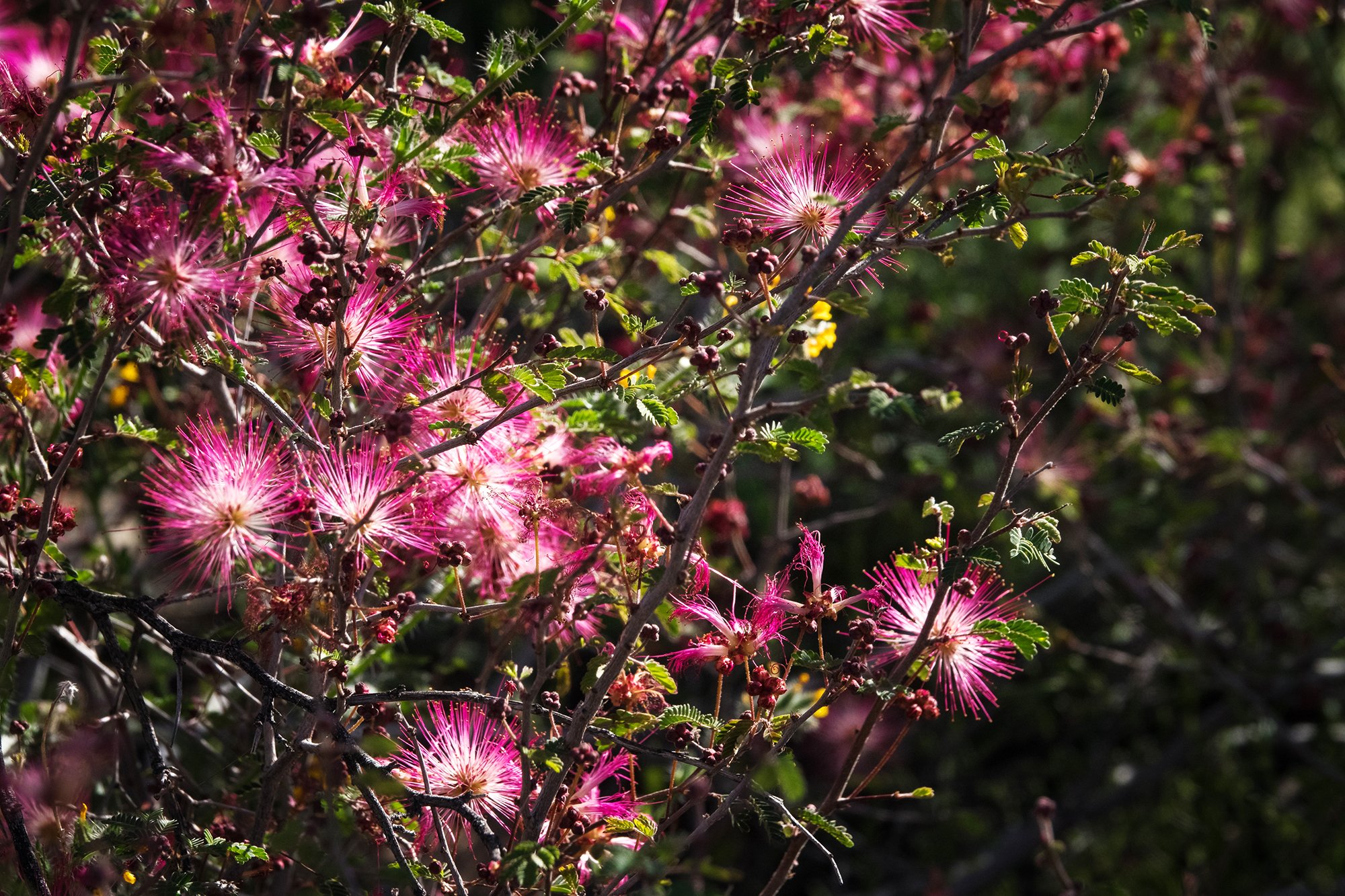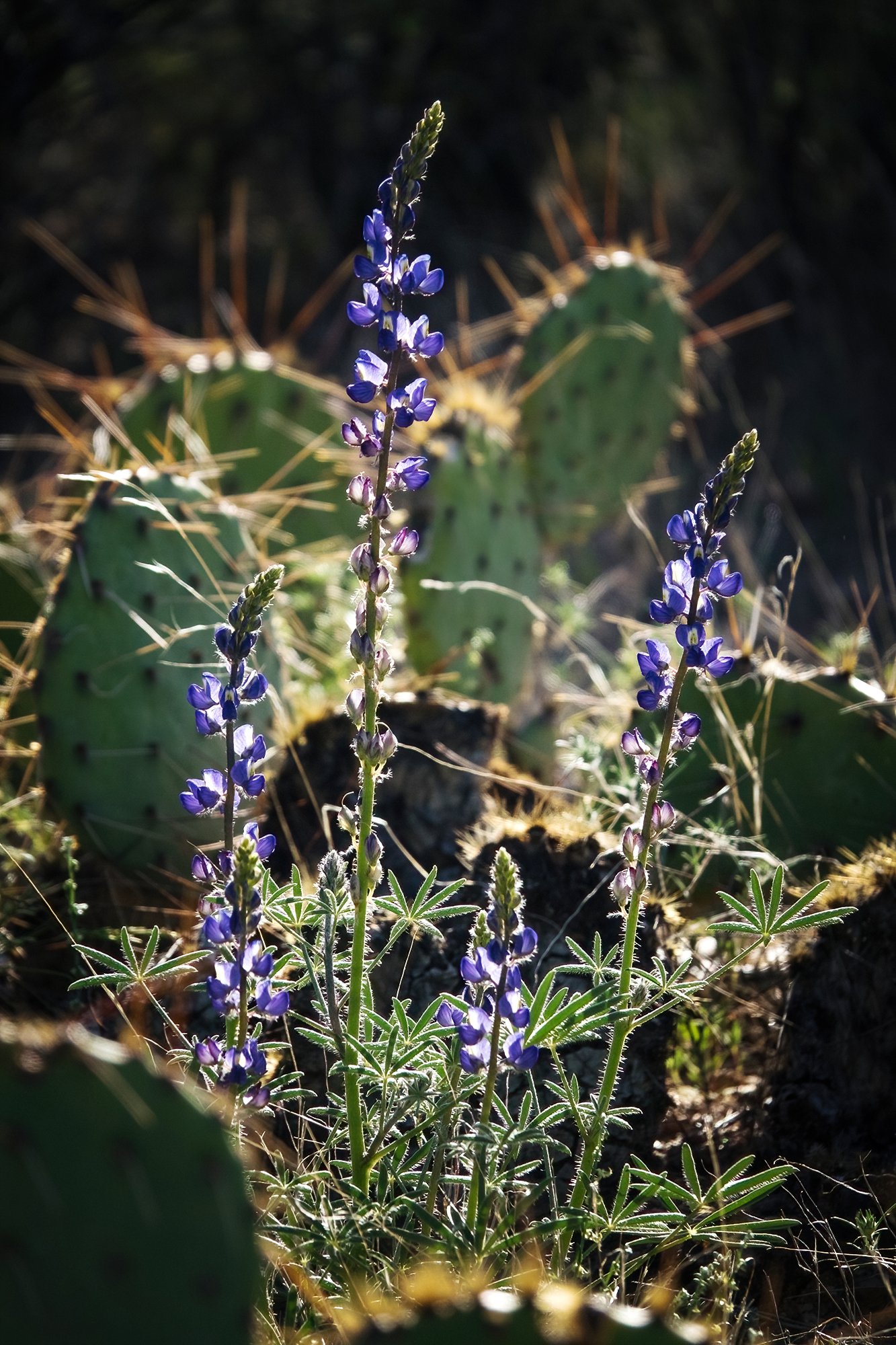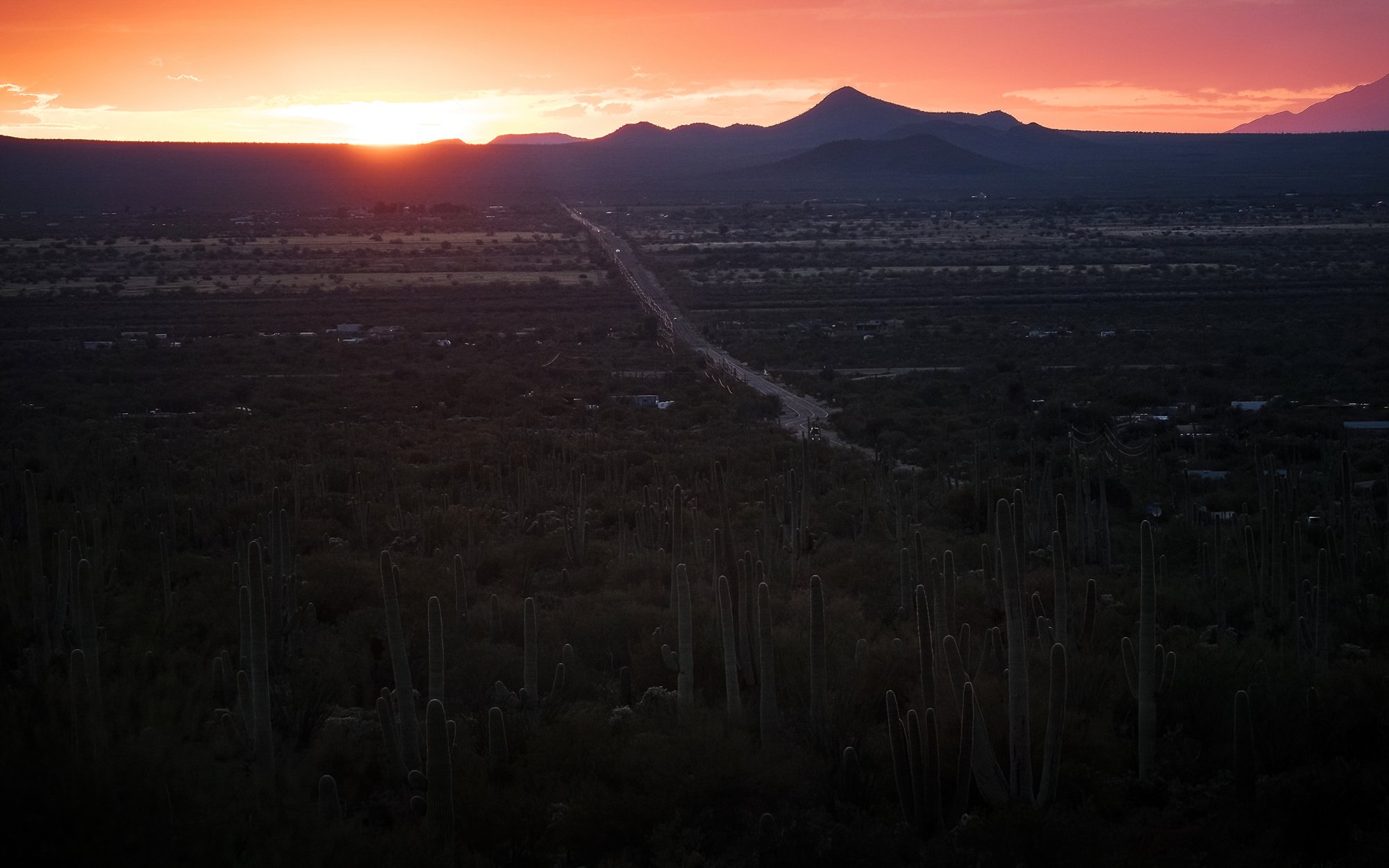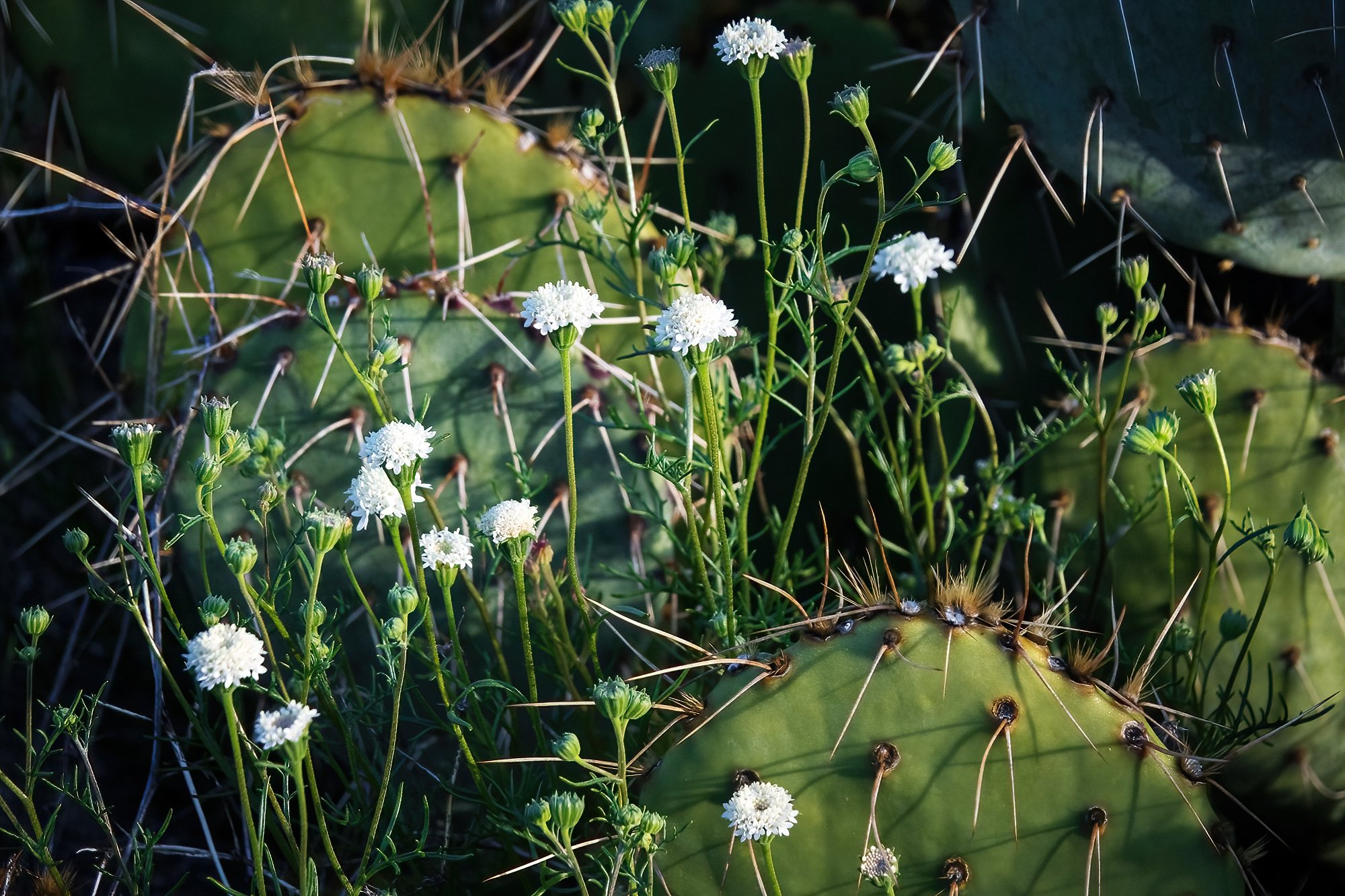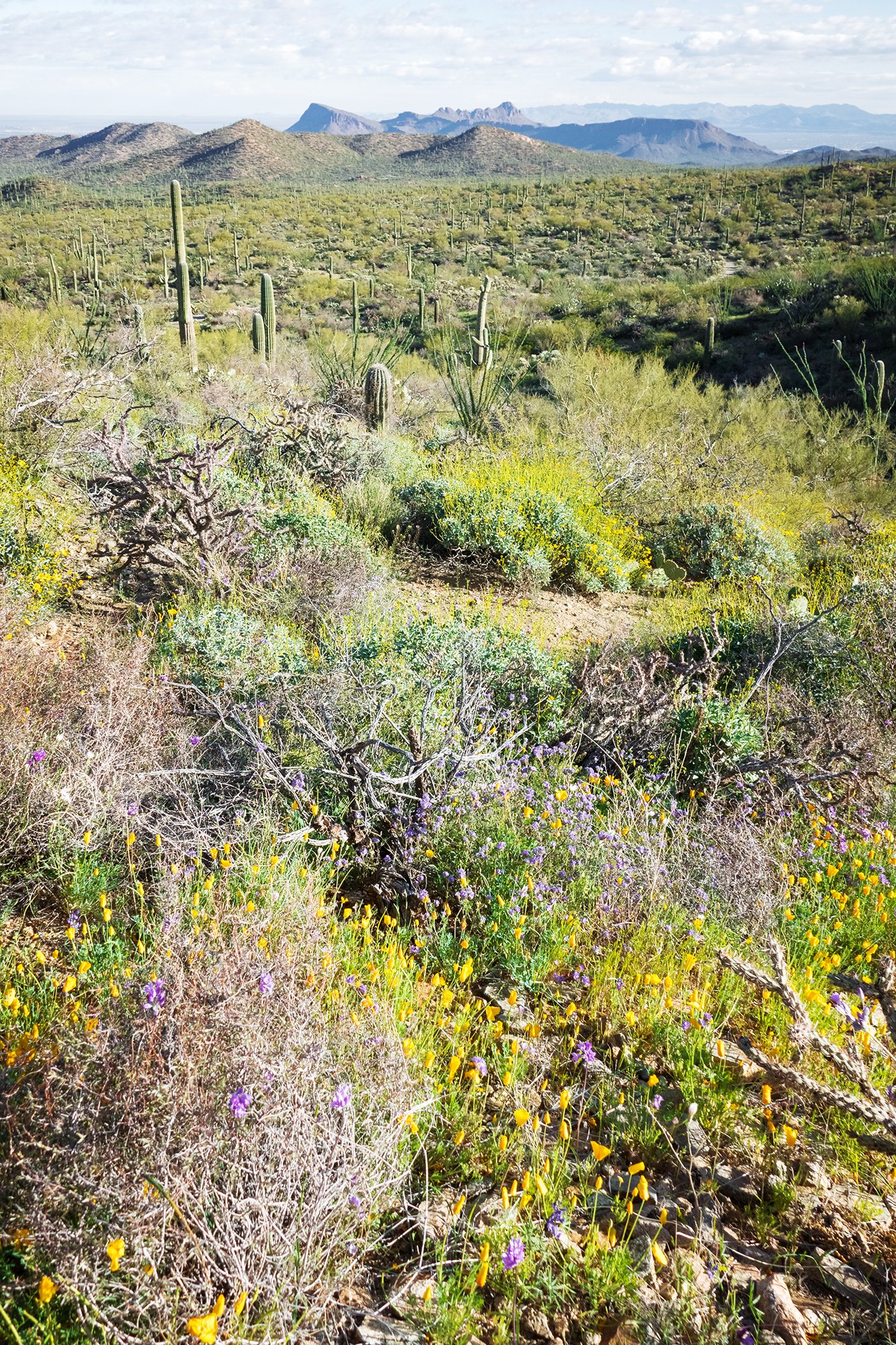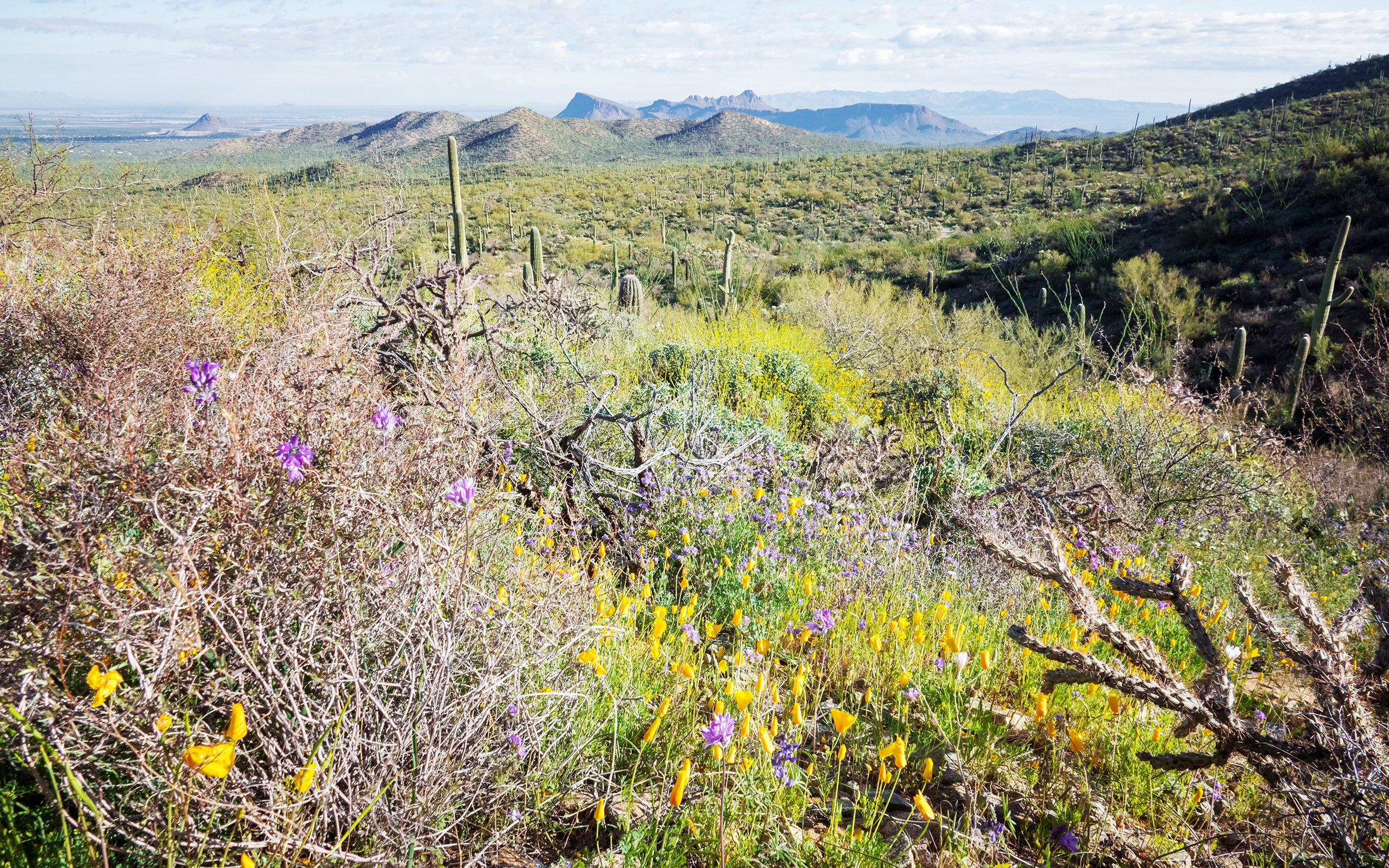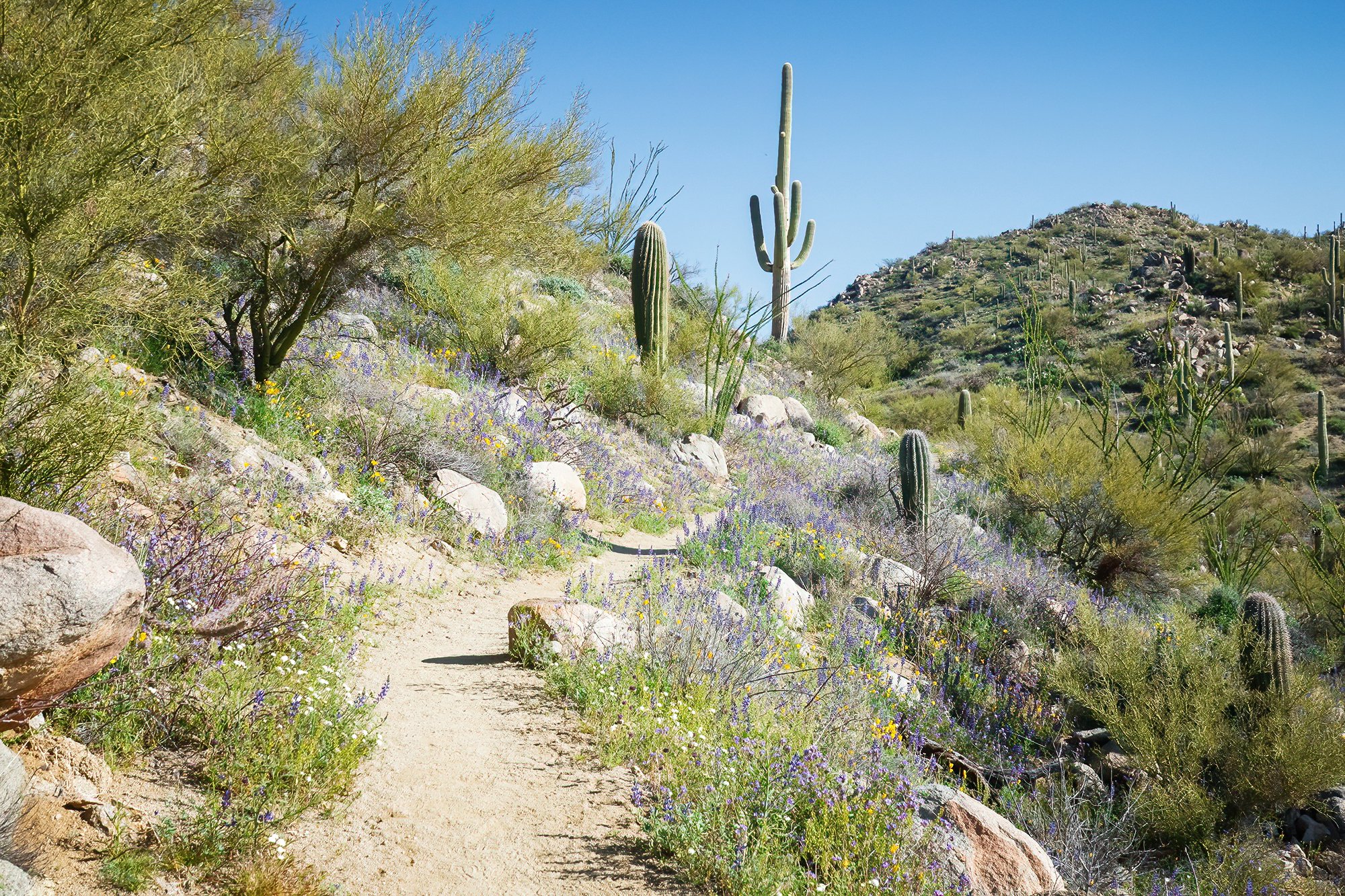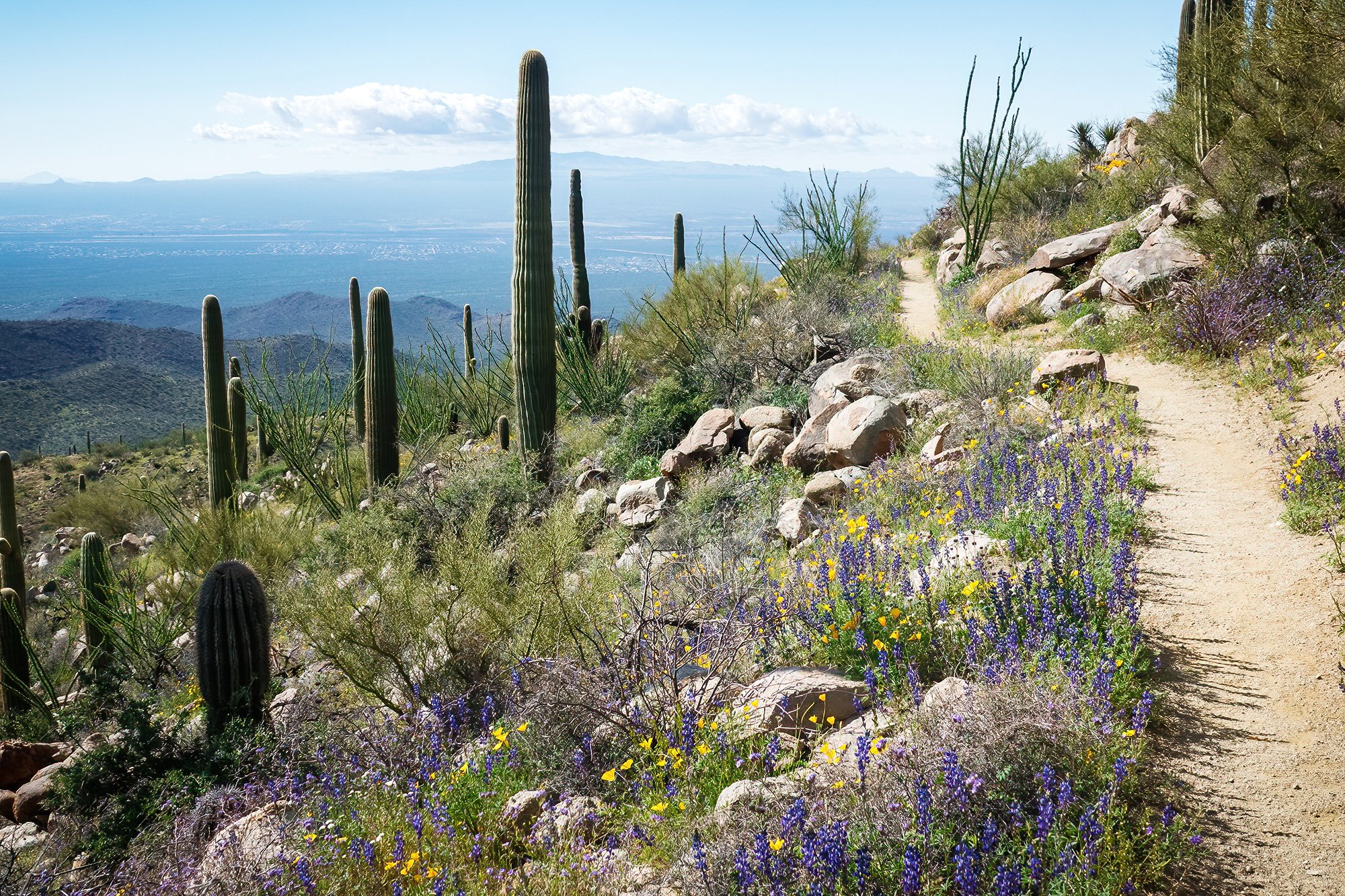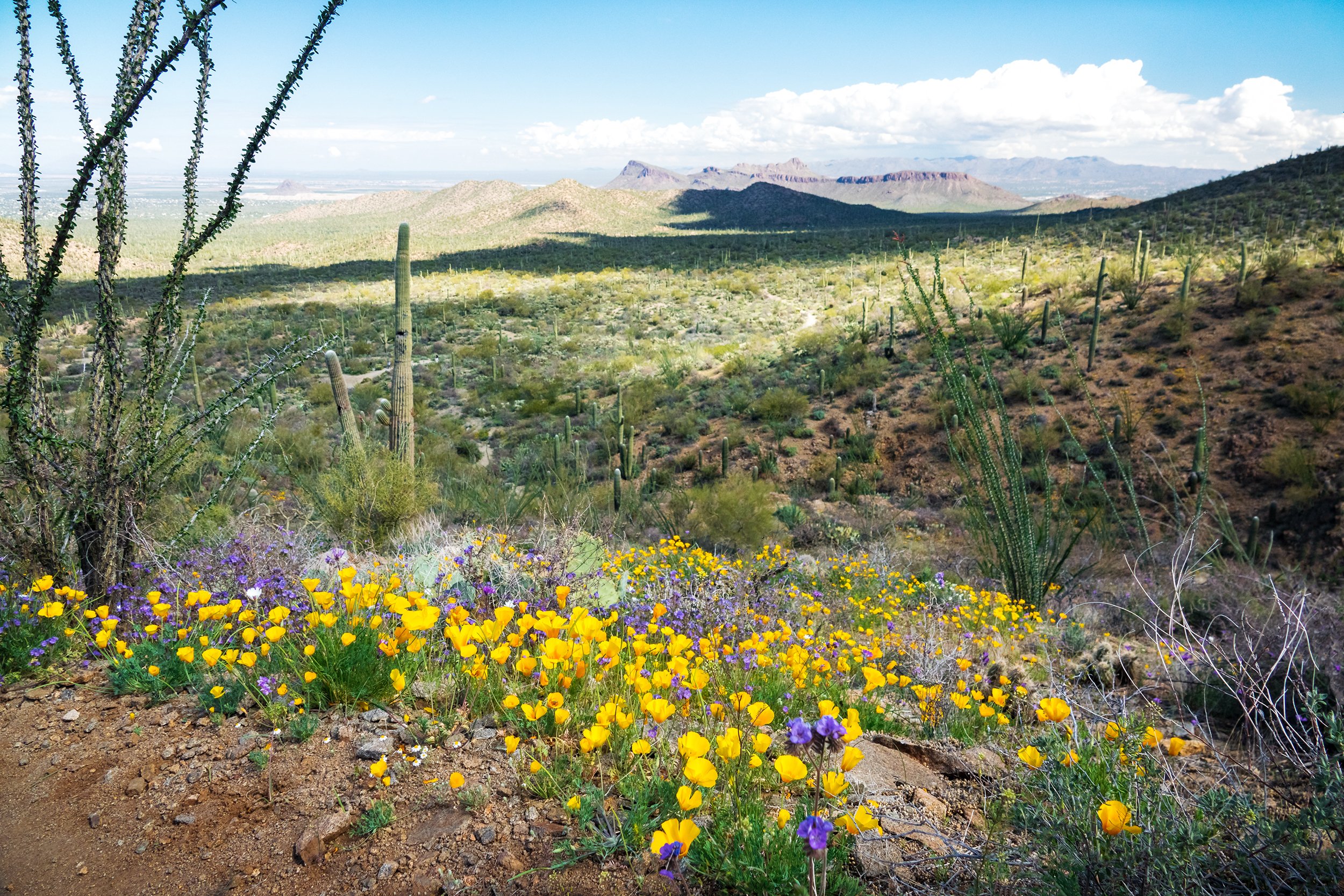It’s been nearly two years since Jane and I took a road trip around the Four Corners region, and nearly three years since our weeklong sojourn in Moab - a long time since I last photographed the austere beauty of the American Southwest. This time, it’s just me, on the road alone in the half-week leading up to attending a professional conference (the AAHPM Annual Assembly) in Arizona. I decide to use these few days to explore a region that had honestly only been faintly on my radar before: the Sonoran Desert around Tucson and Greater Phoenix. The conference organizers have thoughtfully timed the week to coincide with the height of perfect spring weather in the region - clear, blue days that bring fine walking temperatures and carpets of wildflower blooms. For the second month in a row, Jane compassionately shoulders caring for Jordan (and the household) so that I can go off to explore, photograph, and rejuvenate in the desert.
After a busy service week, I oversleep my alarm and nearly (but don’t!) miss my early morning flight. It’s a five-hour trip to the desert megalopolis of Phoenix, during which I watch a movie and read from a book on fiction writing. In short order, I’m leaving the Phoenix airport’s massive rental car complex, heading south on I-10 toward Tucson. Although it’s mid-day on a Saturday, the highway is busy with spring break holiday-goers weaving in and out of shipping traffic. Unsurprisingly, there is a pretty significant backup just south of Phoenix due to a gnarly crash, but fifteen minutes later I am on my way again, bound for the Tucson exurb of Marana, where I’ll be staying for two nights.
Relatively fresh off my trip down the Oregon Coast, it still feels comfortable traveling on my own, and my spirits are buoyed by the lovely, sunny weather and the beauty of the stark desert landscape. My driving jams have been retooled for this trip; gone is the acoustic, melodic soundtrack of New England’s hardwood forests or Oregon’s moody raincoast, and in their place are crunchy guitars, reverb, and atmospheric tracks more fitting for the desert. In the early afternoon, I arrive in Marana and, famished (it’s dinnertime already in Boston), I eat way too much at the local In ‘N Out before stopping into the Walmart next door to buy a gallon of drinking water (a safety precaution for the desert) and a few bottles of orange juice to keep me happy. Then, it’s across the street to my motel for an early check-in and a brief nap to wait out the mid-day sun.
In the late afternoon, I drive out of town and head west along Picture Rocks Road, which climbs from the valley floor and over a pass at the base of the Tucson Mountains. Entering Saguaro National Park’s western unit, I am greeted by a dazzling vista that stretches out across the plains to the west. The roadside is spangled with beds of lupines, fairy dusters, and jewel-flowers, which serve as a stunning color complement to the area’s pale sandstone cliffs and cactus forests. Turning south, I drive a few miles down Sandario Road to the park’s main road loop, first stopping at the visitor center to purchase a pass and a trip magnet. After photographing some of the wildflowers in the desert garden outside, Thinking that the Signal Hill parking area is closed for construction, I return to Sandario Road and leave my car at the intersection with Manville Road, opting to take a slightly longer sunset hike toward Signal Hill.
The dirt path initially parallels the road, winding through stands of verdant, many-tendriled ocotillo plants and gigantic saguaro cacti before turning up a sandy wash. I meander along the wash for the next half-mile, stopping often to the photograph the flora of the desert: globemallows and fiddlenecks flowering in the shade of creosote bushes; and beautiful branching palo verde trees with their smooth, verdant bark. As I near Signal Hill, it becomes rather obvious (from the visible clumps of tourists atop the rock pile) that the nearby parking lot remains quite open, but I am quite glad to have had the solitude of my little walk in the arroyo.
At the top of the hill, I set up my tripod and scout around for compositions including the nearby petroglyphs (backed by the Red Hills, lit by sunset light); wide-angle shots including petroglyphs, wildflowers, and distant mountains; and telephoto compositions compressing the saguaro forest, desert roads receding into the horizon, and the Silverbell Mountains. I am joined throughout the golden hour by a variety of tourists and photographers - hobbyists shooting with professional telelenses and smartphones alike. It’s a fun, judgment-free atmosphere (except for one guy who climbs over a barrier and practically stands on the petroglyphs, whom I scold); we trade compositions, share travel stories, and marvel at the fine weather and the even finer sunset. As I lean against the guardrail waiting for dusk, I feel the fatigue of the travel day evaporating off my body under the warm embrace of the sunset. After the light disappears, I descend the hill and jog back to the highway along the arroyo; then, it’s back to Marana for dinner (takeout from Chipotle) and a night of reading, writing, and resting up.
The next morning, jetlag once again has me up before dawn; I get dressed for a morning of desert hiking and eat a quick motel breakfast before getting in the car. My objective for the morning is the summit of Wasson Peak, at the heart of the Tucson Mountains: a nontechnical but unrelenting climb from the desert floor along the Sendero Esperanza. Driving back west along Picture Rocks Road, I am unable to resist pulling off roadside to meander into the cactus gardens. I photograph the first light of sunrise hitting the nearby clifftops, as well as the nearby beds of wildflowers backlit by the morning sun. Back on the road, I re-enter the national park boundary and navigate along the Bajada Loop, a dirt-and-gravel drive that circles the northern part of the park, eventually making my way to the trailhead for the Sendero Esperanza (“Trail of Hope”). Here, I don my sun protection, take a big swig of water, and set off along the trail. There is no one else around at this early hour of the morning.
The trail heads southwest toward the bulk of the Tucson Mountains, initially climbing very gradually, almost imperceptibly. Despite this, I’m initially moving at a snail’s pace, distracted as I am by the beauty around me. I find myself stopping constantly to take in the scenery, and to shoot macros of the lush wildflower beds that lie nestled at the base of the cacti. Along with flowers such as the ubiquitous bristly fiddlenecks, spreading woolystars, Coulter’s lupines, and fiesta flowers, I see fruiting barrel cacti, prickly pears, and ocotillos (“little torches”) beginning to flower, the slender red petals erupting from their tips like flames. The desert is serene; there is a cool morning breeze lingering in the air, and almost no sounds save for my footsteps and the fluttering of an occasional startled cactus wren.
Further along, the path begins to zigzag up the mountainside; the elevation brings with it new varieties of flora, including carpets of desert poppies, marigolds, and dandelions, and stands of zinnias and beardtongues. Turning back to gaze down the valley floor, I try my best to photograph the landscape together with a foreground of beautiful orange-and-gold flowers; it’s a tricky compositional challenge, what with the chaotic tangle of ocotillo arms and palo verde branches in the midground. Trying to keep in mind my time constraints (due to the heat of the mid-day desert, I’ve resolved to stick to a turnaround time of 9:30 AM), I stop photographing, stuff my outer layer into my backpack and press onward with the climb.
Many switchbacks later, having gained the ridgeline, I take a water break at the trail’s intersection with the Hugh Norris Trail. It’s 8:30 AM (I’ve done a pitiful 1.7 miles in one hour - and the easiest stretch of the walk, at that), but not to be dissuaded, I decide to make the left turn toward Amole and Wasson Peaks, to see how far I can get before my turnaround time. This turns out to be a marvelous decision; even though the soaring sun makes both photography and mountain walking less and less appealing, the ridge walk along the mountains is painted in an absolute profusion of wildflowers. Having gotten my fill of macro shots, I keep my camera down and forge forward, covering nearly 2.5 miles in the next hour. After a steep series of switchbacks, I reach the top of Wasson Peak at exactly 9:30.
After taking a brief break and signing the summit register, I retrace my steps, essentially trail-running my way back to the car with some intermittent breaks for photographing the scenery and the flowers. I am wearing my relatively brand-new trail runners (my first time hiking in anything except for cheap boots), and it feels absolutely glorious to go soaring back down the ridgeline, with breathtaking panoramic views and colorful wildflowers accompanying every step. I must make quite the impression (awkwardly glissading down the mountain with my full photography backpack, including attached tripod and camera-in-hand), as quite a few walkers comment as I pass: “Oh, to have your limbs!” Oh, my limbs will certainly regret this later. “In a rush for lunch?“ Yes, very. “Is there a bear behind you?” There are no bears in the Sonoran Desert, but despite this I cover the return 4 miles in an hour, arriving back at the trailhead well earlier than intended. Back in the car, I rehydrate and make the return drive to Marana, where I get another takeout lunch (a Panda Express with a drive-through; seriously, who the hell designed this gargantuan shopping plaza and why does it have all my favorites?) before retiring to the motel to shower and nap.
After a long break and pretty deep sleep in the afternoon, I head back out to catch sunset. My destination for the evening is on the outskirts of the Ironwood Forest National Monument, a massive wilderness area northwest of Marana, encompassing the Silverbell Mountains and the surrounding foothills and desert plains. Instead of going along the interstate, I choose to take a series of desert backroads to reach Avra Valley Road, the highway that runs westward into monument grounds. A few miles to the west, I pull off Avra Valley Road onto a dirt track; here, I leave the car and set off on foot toward a knoll to the north, from where I hope to gain panoramic views of the mountain ranges to the west, and the hallmark silhouette of Ragged Top to the northwest. Picking my way carefully through stands of saguaro, cholla, and desert ironwood trees, I am cognizant of just how lonely this place is; the nearest housing communities may be just a few miles to the east, but that represents an enormous distance out here, where one wrong step into a cactus or one turn of the ankle could prove to be genuinely problematic.
Turning toward the knoll, I cross a little gully and find an open hillside from which to watch the sunset. Sitting down on a large stone between two palo verdes, I take wide shots of the nearby trees and lupines, and telephoto compositions of the distant mountains and plains; the sidelit saguaros cast lovely, long shadows in the late afternoon night. Surprisingly, I have cell service at this particular spot, so I send Jane a quick video of the sunset - both to share, and to let her know I am doing okay out here in the middle of nowhere. As the sun falls below the horizon, I keep working my handful of compositions (eschewing the tripod completely) until it’s nearly dark. Then it’s back (carefully back, weaving between cacti in the growing dark) to the car. Along the way, I hear a loud, rumbling sound that is unmistakeably the growl of a large animal, and my heart skips a few beats before I remember that a mountain lion would be quite unlikely to announce its intentions so loudly. Instead, around the corner I come face to face with a grazing steer, who thankfully decides to leave me alone, turning tail and bounding off into the brush. Back in the car, I maneuver over a dirt ditch and back onto the highway, making the long drive back to town. The desert roads are pitch-black and desolate but for the high beams of distant cars; they move as if they are comets in the inky darkness of cosmic night.





